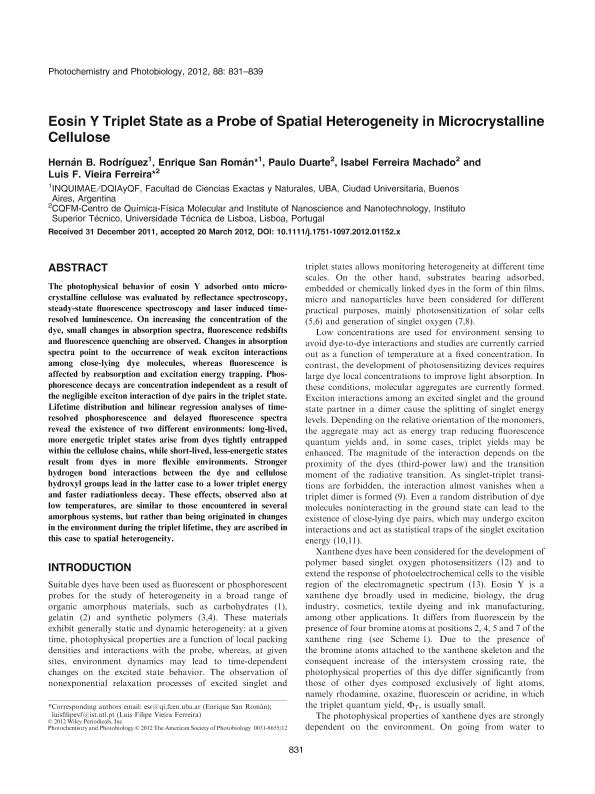Mostrar el registro sencillo del ítem
dc.contributor.author
Rodriguez, Hernan Bernardo

dc.contributor.author
San Roman, Enrique Arnoldo

dc.contributor.author
Duarte, Paulo
dc.contributor.author
MacHado, Isabel Ferreira
dc.contributor.author
Vieira Ferreira, Luis F.
dc.date.available
2019-01-09T17:34:53Z
dc.date.issued
2012-07
dc.identifier.citation
Rodriguez, Hernan Bernardo; San Roman, Enrique Arnoldo; Duarte, Paulo; MacHado, Isabel Ferreira; Vieira Ferreira, Luis F.; Eosin y triplet state as a probe of spatial heterogeneity in microcrystalline cellulose; Wiley Blackwell Publishing, Inc; Photochemistry and Photobiology; 88; 4; 7-2012; 831-839
dc.identifier.issn
0031-8655
dc.identifier.uri
http://hdl.handle.net/11336/67791
dc.description.abstract
The photophysical behavior of eosin Y adsorbed onto microcrystalline cellulose was evaluated by reflectance spectroscopy, steady-state fluorescence spectroscopy and laser induced time-resolved luminescence. On increasing the concentration of the dye, small changes in absorption spectra, fluorescence redshifts and fluorescence quenching are observed. Changes in absorption spectra point to the occurrence of weak exciton interactions among close-lying dye molecules, whereas fluorescence is affected by reabsorption and excitation energy trapping. Phosphorescence decays are concentration independent as a result of the negligible exciton interaction of dye pairs in the triplet state. Lifetime distribution and bilinear regression analyses of time-resolved phosphorescence and delayed fluorescence spectra reveal the existence of two different environments: long-lived, more energetic triplet states arise from dyes tightly entrapped within the cellulose chains, while short-lived, less-energetic states result from dyes in more flexible environments. Stronger hydrogen bond interactions between the dye and cellulose hydroxyl groups lead in the latter case to a lower triplet energy and faster radiationless decay. These effects, observed also at low temperatures, are similar to those encountered in several amorphous systems, but rather than being originated in changes in the environment during the triplet lifetime, they are ascribed in this case to spatial heterogeneity. © 2012 Wiley Periodicals, Inc.
dc.format
application/pdf
dc.language.iso
eng
dc.publisher
Wiley Blackwell Publishing, Inc

dc.rights
info:eu-repo/semantics/openAccess
dc.rights.uri
https://creativecommons.org/licenses/by-nc-sa/2.5/ar/
dc.subject
Eosin Y
dc.subject
Cellulose
dc.subject
Fluorescence
dc.subject
Phosohorescence
dc.subject.classification
Otras Ciencias Químicas

dc.subject.classification
Ciencias Químicas

dc.subject.classification
CIENCIAS NATURALES Y EXACTAS

dc.title
Eosin y triplet state as a probe of spatial heterogeneity in microcrystalline cellulose
dc.type
info:eu-repo/semantics/article
dc.type
info:ar-repo/semantics/artículo
dc.type
info:eu-repo/semantics/publishedVersion
dc.date.updated
2019-01-02T19:10:19Z
dc.journal.volume
88
dc.journal.number
4
dc.journal.pagination
831-839
dc.journal.pais
Reino Unido

dc.journal.ciudad
Londres
dc.description.fil
Fil: Rodriguez, Hernan Bernardo. Consejo Nacional de Investigaciones Científicas y Técnicas. Oficina de Coordinación Administrativa Ciudad Universitaria. Instituto de Química, Física de los Materiales, Medioambiente y Energía. Universidad de Buenos Aires. Facultad de Ciencias Exactas y Naturales. Instituto de Química, Física de los Materiales, Medioambiente y Energía; Argentina. Universidad de Buenos Aires. Facultad de Ciencias Exactas y Naturales. Departamento de Química Inorgánica, Analítica y Química Física; Argentina
dc.description.fil
Fil: San Roman, Enrique Arnoldo. Consejo Nacional de Investigaciones Científicas y Técnicas. Oficina de Coordinación Administrativa Ciudad Universitaria. Instituto de Química, Física de los Materiales, Medioambiente y Energía. Universidad de Buenos Aires. Facultad de Ciencias Exactas y Naturales. Instituto de Química, Física de los Materiales, Medioambiente y Energía; Argentina. Universidad de Buenos Aires. Facultad de Ciencias Exactas y Naturales. Departamento de Química Inorgánica, Analítica y Química Física; Argentina
dc.description.fil
Fil: Duarte, Paulo. Universidade Tecnica de Lisboa; Portugal
dc.description.fil
Fil: MacHado, Isabel Ferreira. Universidade Tecnica de Lisboa; Portugal
dc.description.fil
Fil: Vieira Ferreira, Luis F.. Universidade Tecnica de Lisboa; Portugal
dc.journal.title
Photochemistry and Photobiology

dc.relation.alternativeid
info:eu-repo/semantics/altIdentifier/doi/https://dx.doi.org/10.1111/j.1751-1097.2012.01152.x
dc.relation.alternativeid
info:eu-repo/semantics/altIdentifier/url/https://onlinelibrary.wiley.com/doi/abs/10.1111/j.1751-1097.2012.01152.x
Archivos asociados
